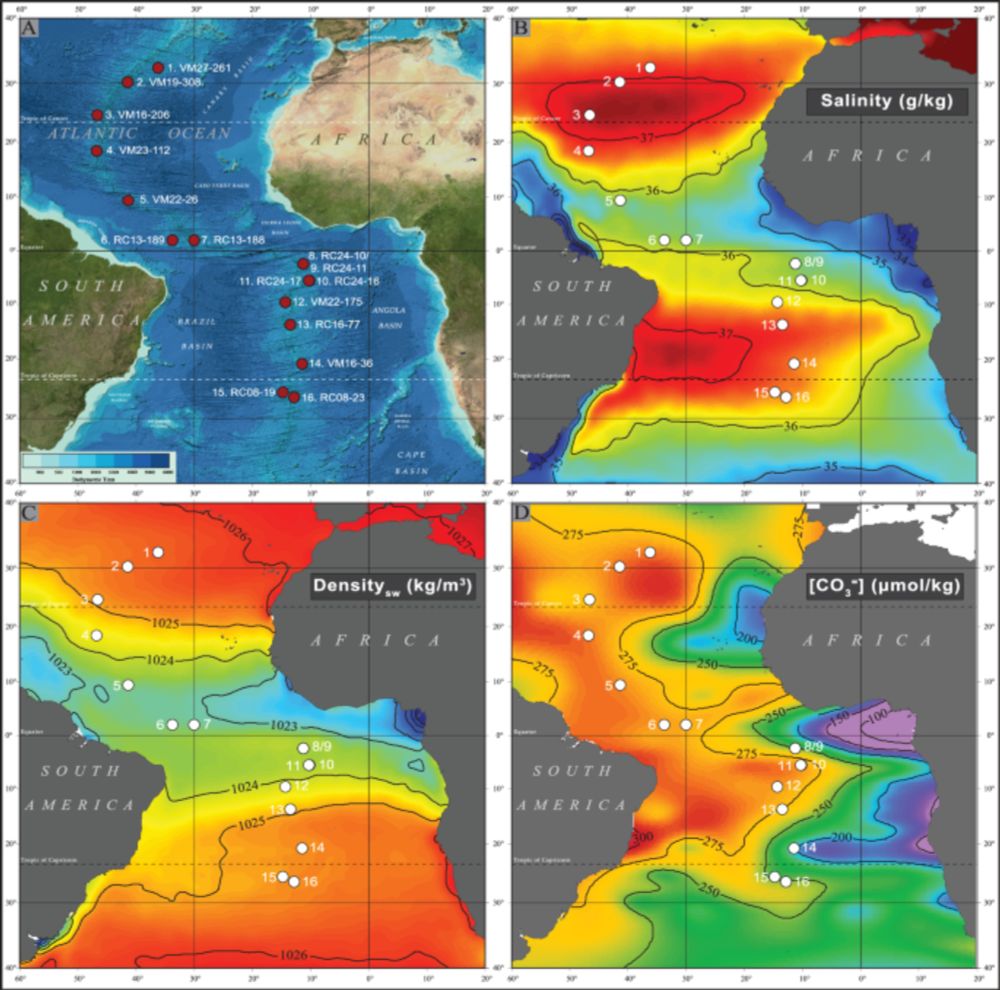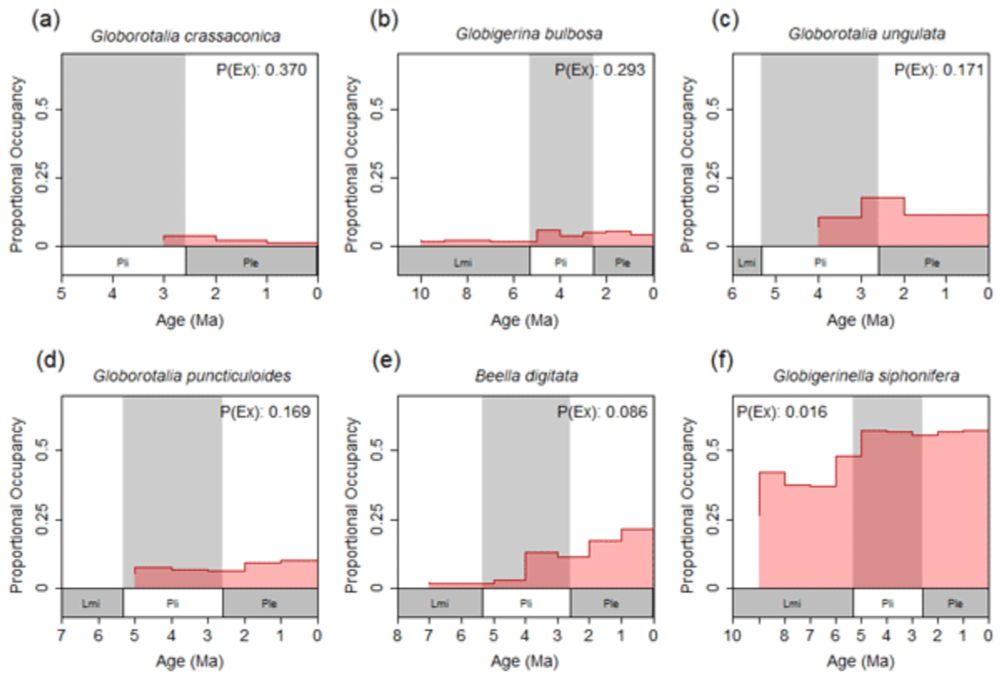Thanks Pallavi! Lots to do together in the future! Looking forward to it! :D
04.12.2025 10:24 — 👍 1 🔁 0 💬 0 📌 0
Thanks Neil! Lots of ideas to talk through that's for sure! 😄
02.12.2025 19:38 — 👍 0 🔁 0 💬 0 📌 0
In line with previous work, we invoke substantial changes in the thermal and nutrient structure of the global water column associated with the inception of the Antarctic ice sheet as the primary mechanism for these changes.
02.12.2025 11:49 — 👍 3 🔁 0 💬 0 📌 0

This pattern is replicated on the global scale, where we looked at the same assemblage dynamics using the Triton dataset.
02.12.2025 11:49 — 👍 3 🔁 0 💬 1 📌 0

By assigning planktonic foraminifera to the functional ecological niche groups (ecogroups), we found that the assemblages in the western equatorial Atlantic exhibit a distinct turnover from communities dominated by warm-water dwellers to those dominated by cold-water dwellers.
02.12.2025 11:49 — 👍 2 🔁 0 💬 1 📌 0

In this study, we (myself, Kirsty Edgar, Tom Dunkley Jones, Carina Hoorn, Bridget Wade) analysed planktonic foraminifera from the Amazon Fan, where the Eocene-Oligocene sediments represent a rare low-latitude record of ecosystem change across the Greenhouse-Icehouse climate transition.
02.12.2025 11:49 — 👍 2 🔁 0 💬 1 📌 0
Great opportunity here to study the Earth system during the often overlooked early Miocene. Application details here!
27.11.2025 00:23 — 👍 4 🔁 2 💬 0 📌 0
If you are interested in the Early Miocene, this is a great opportunity. There is an upcoming Webinar on 4 Dec on the project. Check it out and consider trying out for the expedition. ⚒️
plymouth.zoom.us/webinar/regi...
26.11.2025 19:41 — 👍 7 🔁 4 💬 0 📌 0
Or any of the other members of the co-proponent team and Early Miocene Working Group who contributed towards ENIGMA Adriane Lam, Alexandra Auderset, Anshuman Swain, Anta-Clarisse Sarr, Anya Hess, Elizabeth Sibert, Gawain Antell, Imogen Browne, Jansen Smith, Jesse Farmer, Kenji Matsuzaki
26.11.2025 16:54 — 👍 1 🔁 0 💬 0 📌 0
If you have any comments or questions in meantime, please reach out to the Co-Chief scientists myself (woodhousea2@cardiff.ac.uk) and Jennifer Kasbohm (jkasbohm@carnegiescience.edu).
26.11.2025 16:54 — 👍 1 🔁 0 💬 1 📌 0
LinkedIn
This link will take you to a page that’s not on LinkedIn
Also, please do register for the webinar to be held on December 4th 2025 at 1100 UTC where the Expedition team will provide more information and be happy to take any questions from the community: lnkd.in/eqFUcWn8
26.11.2025 16:54 — 👍 1 🔁 0 💬 1 📌 0
LinkedIn
This link will take you to a page that’s not on LinkedIn
The Expedition page and Scientific Prospectus can be found at this link, which gives more detail on the Scientific Objectives of Expedition 505S: lnkd.in/eXMvVkCW
26.11.2025 16:54 — 👍 1 🔁 0 💬 1 📌 0
LinkedIn
This link will take you to a page that’s not on LinkedIn
We will use sedimentological, geochemical, micropalaeontological, and Earth system modelling methods. Therefore, we encourage participation from individuals from the entire suite of Earth science expertise.
The call to participate can be found here: lnkd.in/etiWvk2z
26.11.2025 16:54 — 👍 1 🔁 0 💬 1 📌 0
LinkedIn
This link will take you to a page that’s not on LinkedIn
ENIGMA (ExploratioN Into a Global early Miocene Anomaly) seeks to investigate abiotic and biotic changes across the entire Atlantic Ocean and Caribbean Sea by assembling a team of scientists to explore the early Miocene @ukiodp.bsky.social @ecord.bsky.social
26.11.2025 16:54 — 👍 2 🔁 0 💬 1 📌 0

Applications for Participation in IODP3 Expedition 505S are now open!
Deadline January 23rd 2026 - lnkd.in/etiWvk2z
If you are a researcher/science communicator interested in contributing to understanding an enigma in the early Miocene Earth system then please consider applying this expedition!
26.11.2025 16:54 — 👍 3 🔁 4 💬 1 📌 3
Today my @nytimes.com colleagues and I are launching a new series called Lost Science. We interview US scientists who can no longer discover something new about our world, thanks to this year‘s cuts. Here is my first interview with a scientist who studied bees and fires. Gift link: nyti.ms/3IWXbiE
08.10.2025 23:29 — 👍 4736 🔁 1835 💬 142 📌 83

ecoevojobs.net 2025-26
UPDATE: The 2025-2026 list of faculty and postdoc positions in ecology and evolutionary biology is out! Be sure to check out this active and helpful community run resources! docs.google.com/spreadsheets...
19.09.2025 21:47 — 👍 242 🔁 227 💬 2 📌 6
Data Steward within the Excellence Cluster OCEAN FLOOR – Earth´s Uncharted Interface // University of Oldenburg
The excellence cluster Ocean floor @marumunibremen.bsky.social @icbm-uol.bsky.social @hifmb.de opens two strategic positions at the University of Oldenburg. Please distribute widely
Scientific Coordinator: uol.de/job723en
Data Steward: uol.de/job724en
12.09.2025 08:24 — 👍 19 🔁 19 💬 0 📌 1
Assistant or Associate Professor, Physical Geography (T/TE) (Updated)
Develop and maintain an active research program.Teach undergraduate and graduate courses.Develop advanced courses at the graduate level.Mentor and adv...
The University of Arizona is hiring a tenure-track Assistant/Associate Professor in Physical Geography! Research specialities could include wildfire, climate and water resources, and/or natural hazards, amongst others. Please apply and join us! arizona.csod.com/ux/ats/caree...
14.08.2025 18:10 — 👍 46 🔁 51 💬 1 📌 1
Assistant Curator (Vertebrates)
Rare as hen's teeth: an Assistant Curator job, with our fantastic team at National Museums Scotland! Closing date 24th August #museums #museumjobs
careers.nms.ac.uk/job/748553
14.08.2025 11:14 — 👍 32 🔁 39 💬 0 📌 0

🆕 Our researcher Graham Mortyn, co-author of this new study Published in "Communications Earth & Environment".
nature.com/articles/s4324…
15.08.2025 08:44 — 👍 2 🔁 2 💬 0 📌 0
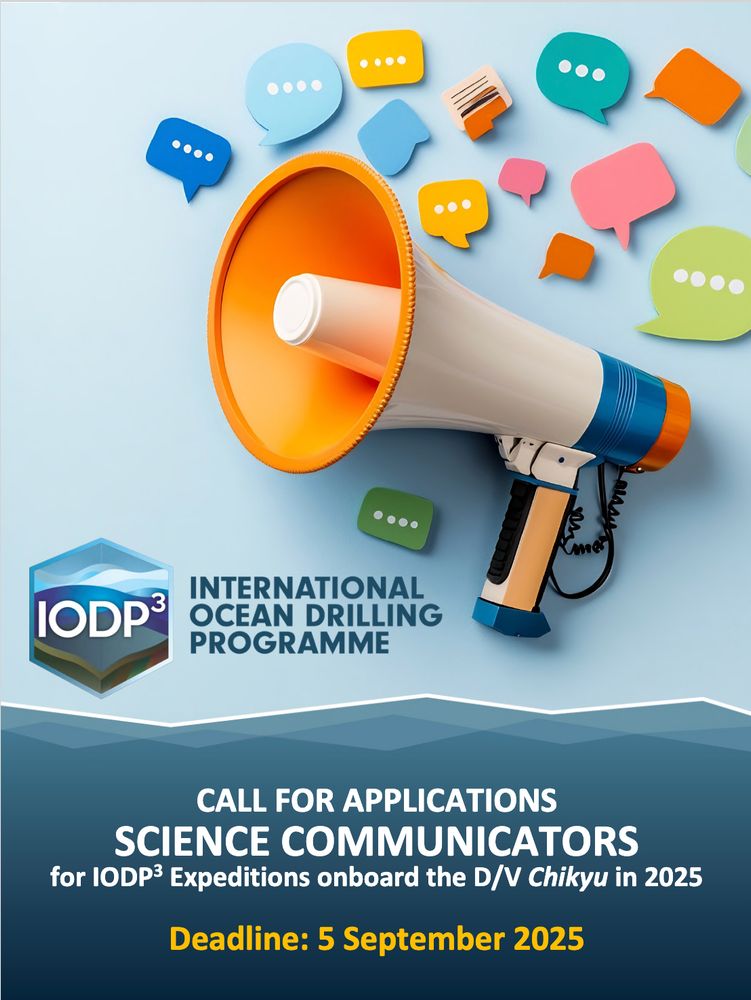
Hey Science Communicators - We are looking for you - join us on an IODP³ Expedition this year #Scicomm #OceanDrilling
14.08.2025 08:20 — 👍 6 🔁 4 💬 1 📌 2
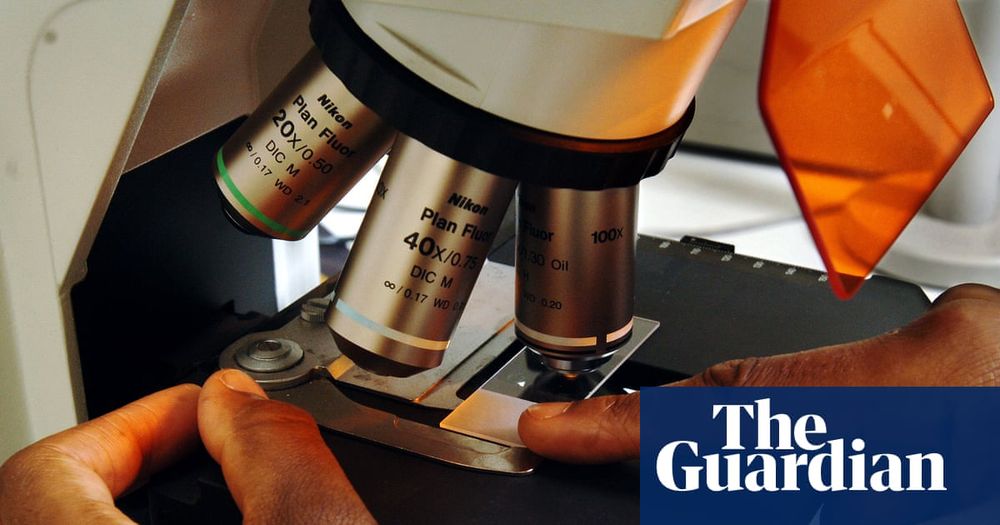
UK recovers position in EU’s Horizon Europe science research programme
Scientists received €735m in grants in 2024 after UK rejoined programme as associate member post-Brexit
UK recovers position in EU’s Horizon Europe science research programme
Scientists received €735m in grants in 2024 after UK rejoined the programme as associate member post-Brexit 👏
www.theguardian.com/science/2025...
13.08.2025 09:34 — 👍 328 🔁 78 💬 12 📌 6
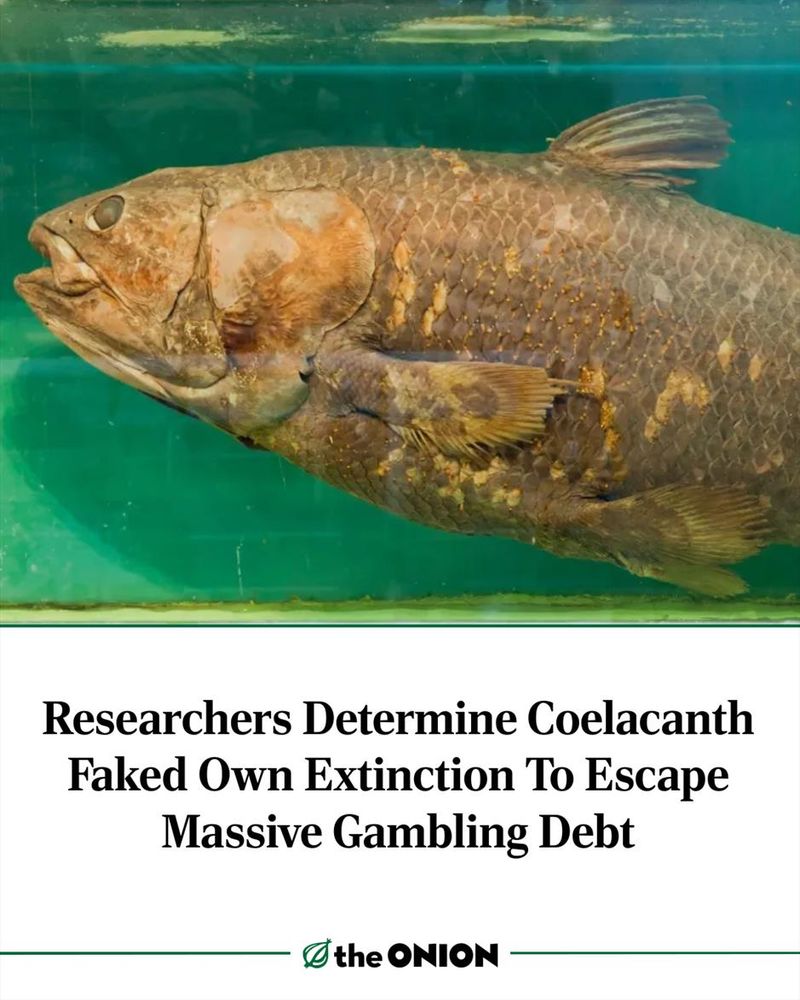
Researchers Determine Coelacanth Faked Own Extinction To Escape Massive Gambling Debt
Researchers Determine Coelacanth Faked Own Extinction To Escape Massive Gambling Debt theonion.com/researc...
01.08.2025 22:00 — 👍 5949 🔁 864 💬 82 📌 64
Postdoc at Bristol as part of the Henehan lab's PETRARCH project. Growing radiolarians for B and Si isotopes. Interested in all things marine silica.
Merman from ancient oceans 🐚🌊🌈 working at @exoceanlab.bsky.social | @cerege.bsky.social 🇨🇵
Palaeontologist working on trilobites and other Palaeozoic arthropods.
Postdoctoral Researcher at the Yunnan Key Laboratory for Palaeobiology 🇨🇳
Huelva, Andalusia 🇪🇸
We are the Open University's School of Environment, Earth & Ecosystem Sciences, investigating past & present environments, creating positive actions in response to the climate emergency: https://www5.open.ac.uk/stem/environment-earth-ecosystem-sciences.
Earth System Modeller, #climate and #sustainability researcher,
Director for Sustainability Research,
Open Societal Challenges Programme, The Open University, UK
Interested in #Ocean #biogeochemistry, #Monsoon #paleoclimate, #Paleoceanography, #EarthSystemScience, #foraminifera , #biominerals , #Diversity #Inclusion #IODP, #geochemistry
Organised #ICP15
NERC Independent Research Fellow at National Museums Scotland. Studies fossils, writes books, hikes mountains, drinks tea, knits jumpers. Chair of Scottish Geology Trust, Secretary of PalSoc 🏳️🌈
https://elsapanciroli.wordpress.com/
European Research Council, set up by the EU, funds top researchers of any nationality, helping them pursue great ideas at the frontiers of knowledge. #HorizonEU
(Palaeo)biologist, studies climate change impacts on marine life, amateur pirate, statistics and sci-fi lover, cyclist
Climate, extinction, and biodiversity scientist researching Earth’s past for a better future. Writing and podcasting for the planet. Chaotic good professor. Forever DM. Working to be a good ancestor. She/her. @makeaplanetpod.bsky.social
📈 Strategic data analyst @UHasselt
🌊 Paleoceanographer by training @YaleUniversity and @KULeuven.
🇧🇪 🇺🇸 Fulbright & BAEF fellow (boat 2014)
🔬 🐚 Lover of microfossils, Open Science,
🌪️ 🌀 ⛈️ Climate and extreme weather
ORCID: 0000-0003-1248-3188
Scientist Interested in all things oceans and climate (esp. carbon cycle). Bike rider, hiker and nature lover. Privileged white feminist. Advocate for diversity.
Volcanologist @ Laboratoire Magmas et Volcans
IODP EXP 398 🌋
LATEST RESEARCH 🌋;
https://www.science.org/doi/10.1126/sciadv.ads9642
https://www.sciencedirect.com/science/article/pii/S0012821X25004315?via%3Dihub
The European Petrophysics Consortium (University of Leicester and @umontpellier.bsky.social) brings downhole logging and core physical properties services to @ecord.bsky.social and IODP3
Strengthening Paleontology - The German hub for global cooperation / Bringing together Paleontologists to develop a long-term research vision with international knowledge exchange and novel scientific cooperation-https://www.paleosynthesis.nat.fau.de/
Palaeobiologist interested in biodiversity patterns over long timescales 📉
Postdoc at @gfz.bsky.social 🇩🇪
Co-chair of @besmacro.bsky.social, member of @paleodb.bsky.social committee and @palaeoverse.bsky.social dev team 👩💻
She/her
Marine Ecology - Plankton - Biodiversity | IRD Researcher at CEREGE, France
Lecturer / cryosphere microbiologist / snowball earth speculator.
Views solely my own.
PhD Student in Palaeoecology of dinosaurs, Palaeoneurology of Theropods dinosaurs, Palaeoecosystem-dynamicist at UCL and NHM, Advocate for Equality, Diversity and Inclusion
Micropaleontologist.
#Radiolaria
🔬🌊🦠












